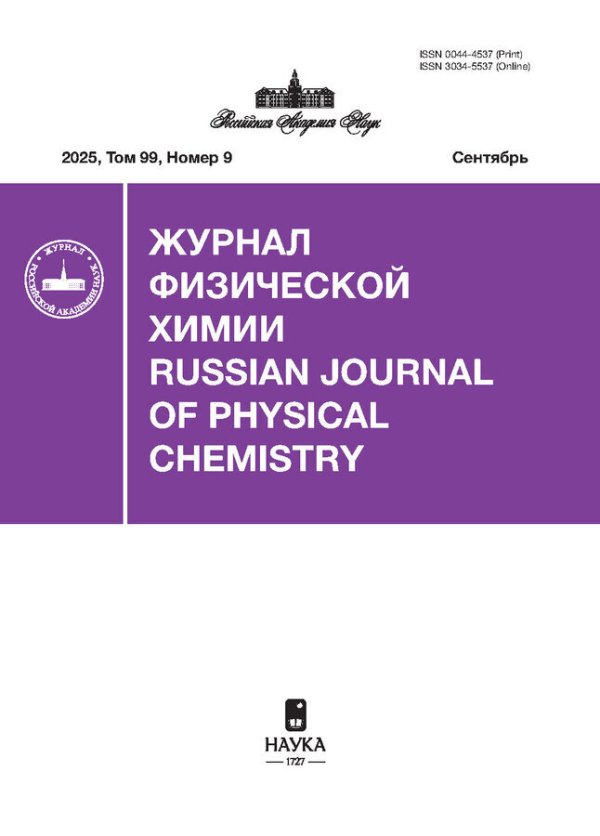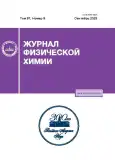Some Features of Quantitative Analysis of Surface Compounds by Laser Desorption Mass Spectrometry
- Authors: Pytskii I.S.1, Kuznetsova E.S.1, Buryak A.K.1
-
Affiliations:
- Frumkin Institute of Physical Chemistry and Electrochemistry
- Issue: Vol 97, No 9 (2023)
- Pages: 1336-1342
- Section: PHYSICAL CHEMISTRY OF DISPERSED SYSTEMS AND SURFACE PHENOMENA
- Submitted: 15.10.2023
- Published: 01.09.2023
- URL: https://journals.rcsi.science/0044-4537/article/view/136670
- DOI: https://doi.org/10.31857/S0044453723090169
- EDN: https://elibrary.ru/XPJBOM
- ID: 136670
Cite item
Full Text
Abstract
The results of quantitative analysis of widely used surface samples are shown. Corrosion damage to copper and steel surfaces can be analyzed quantitatively using cobalt chloride as the internal standard. The study also demonstrates the feasibility of comparative quantitative analysis of blue ink using methylene blue homologues as standards. When conducting quantitative analysis on surfaces with inhomogeneous morphology, it has been observed that direct analysis is not possible because of uneven ionization of the sample. It has been found that when analyzing such surfaces, it is necessary to exclude points with a low signal-to-noise ratio from consideration. The work highlights the extensive possibilities of utilizing quantitative analysis in mass spectrometric visualization of the surface. The work is aimed at demonstrating the capabilities of the laser desorption mass spectrometric method for analyzing the surfaces of various materials, which will make this method universal for searching for a wide range of contaminants on the surface of materials of various nature.
About the authors
I. S. Pytskii
Frumkin Institute of Physical Chemistry and Electrochemistry
Email: ivanpic4586@gmail.com
119991, Moscow, Russia
E. S. Kuznetsova
Frumkin Institute of Physical Chemistry and Electrochemistry
Email: ivanpic4586@gmail.com
119991, Moscow, Russia
A. K. Buryak
Frumkin Institute of Physical Chemistry and Electrochemistry
Author for correspondence.
Email: ivanpic4586@gmail.com
119991, Moscow, Russia
References
- Picó Y. // Curr. Opin. Environ. Sci. 2020. T. 18. № 1. C. 47.
- Feider C.L., Krieger A., DeHoog R.J., Eberlin L.S. // Anal. chem. 2019. T. 91. № 7. C. 4266.
- Ural N. Open Geosci. 2021. T. 13. № 4. C. 197.
- Khan H., Yerramilli A.S., D’Oliveira A. et al. // Can. J. Chem. Eng. 2020. T. 98. № 6. C. 1255.
- Wójtowicz A., Wietecha-Posłuszny R. // Appl. Phys. A. 2019. T. 125. № 1. C. 1.
- Hong Y., Birse N., Quinn B. et al. // J. Food Sci. 2022. T. 6. № 9. C. 14.
- Hou T.Y., Chiang-Ni C., Teng S.H.J. // Food Drug Anal. 2019. T. 27. № 2. C. 404.
- Welker M., Van Belkum A., Girard V. et al. // Expert Rev. Proteomics. 2019. T. 16. № 9. C. 695.
- Pytskii I.S., Minenkova I.V., Kuznetsova E.S. et al. // Pure Appl. Chem. 2020. T. 92. № 3. C. 1227.
- Pytskii I.S., Kuznetsova E.S., Buryak A.K. // Russ. J. Phys. Chem. A. 2021. T. 95. № 11. C. 2319.
- Pytskii I.S., Kuznetsova E.S., Buryak A.K. // Ibid. 2022. T. 96. № 10. C. 2215.
- Minenkova I.V., Pytskii I.S., Buryak A.K. // Prot. Met. Phys. Chem. Surf. 2022. T. 58. № 6. C. 605.
- Schulz S., Becker M., Groseclose M.R. et al. // Curr. Opin. Biotechnol. 2019. T. 55. № 2. C. 51.
- Hendel K.K., Bagger C., Olesen U.H. et al. // Drug deliv. 2019. T. 26. № 1. C. 244.
- Morosi L., Matteo C., Meroni M. et al. // Talanta. 2022. T. 237. № 1. C. 122918.
- Iartsev S.D., Pytskii I.S., Zenkevich I.G., Buryak A.K. // J. Anal. Chem. 2017. T. 72. № 6. C. 624.
- Ibrahim S., Froehlich B.C., Aguilar-Mahecha A. et al. // Anal. Chem. 2020. T. 92. № 18. C. 12407.
- Rzagalinski I., Volmer D.A. et al. Biochim. Biophys. Acta Proteins Proteom. 2017. T. 1865. № 11. C. 726.
Supplementary files
















